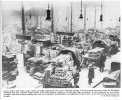The horses are fairly small; and the one on the left is a pony, probably about 14.2 hands (a hand being 4 inches, = 4 ft 10 ins at the top of the shoulder). The size of horse or pony bought would depend on the load to be hauled, and the steepness of the hills on its round. Nowadays, a haulier will buy the smallest vehicle which is up to the job, as the smaller the vehicle, the lower the purchase price and running costs - so with horses. The smaller the horse, or pony, the less it cost to buy and to feed. Bear in mind, too, that supplies being delivered were far lighter than a load of, say, coal - plus another advantage of a fairly light horse for deliveries is that they can move at a brisk trot between customers, so covering their rounds in less time.
HTH
Jack











